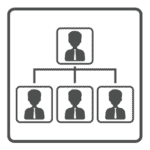The business model canvas is the best tool to help you to organize your business model in an easy-to-read format. This type of diagram can help you figure out what your target audience wants, how you plan on selling your products and/or services, and even forecast how much revenue you expect to generate each month.
What is a Business Model Canvas?
A business model canvas (BMC) is a business and marketing tool and it serves as a guide for entrepreneurs or business owners to create business models. The BMC has key information about the business such as customer segments, value proposition, cost structure, and revenue streams.
Business Model Canvas Template
Using the business model template helps business owners see how all of the key business elements fit together. The business model canvas template is structured to help business owners think about how they are going to fill their business with customers, money, and resources all at once.
A business model canvas is made up of nine elements to include:
- Key Partners
- Key Activities
- Key Resources
- Value Proposition
- Customer Relationships
- Distribution Channels
- Customer Segments
- Cost Structure
- Revenue Streams
By using this business model canvas template, business owners can make sure that their business has the financial backing it needs while also making sure it attracts the right customer demographic.
If business owners use the business model canvas template they can ensure that their business idea is feasible and profitable. The business model canvas template also allows business owners to self-assess, which can help make the business planning process easier for them in the long run.
How To Create a Canvas Model For Your Business
The business model canvas is key to business planning. It is an essential business tool that business owners need to use when they are creating business plans or nurturing business ideas.
Business owners can create a business model canvas by answering the questions provided for each section of the canvas below.
Key Partners
The Key Partners section should include a list of all business partners, companies, or other individuals that are involved in making this company a success. This part will help to determine how much revenue each person can contribute and if there is another way that they could be compensated for their efforts, such as getting paid with equity instead.
- Who are your key partners?
- Who else has an interest in the company’s success?
- How do they contribute to its growth?
For example, if you’re using the affiliate model, then one of your key partners’ lists might include a blogger who agrees to write about your product in order to generate more leads.
Key Activities
The Key Activities section will include a list of all the tasks that need to be completed in order for this model to work.
- What activities are required to support your value proposition?
- What activities are required to support your advertising model?
- What activities are required to support the relationships with your consumers?
- What activities are required to support your revenue sources?
For example, if you’re using paid search advertising, then it’s necessary to complete research on keywords and create ads that meet specific criteria.
Key Resources
The Key Resources section should focus on what types of equipment, labor, and funds are needed in order to make this business successful.
- What equipment is needed to start this business?
- What type of labor does this business require?
- How much funding will I need in order to start this business?
For example, if you’re using paid search marketing then you will need a computer that has access to the internet as well as specific programs for creating ads.
Value Proposition
The Value Proposition section details what your customer base will receive in return for their money and time, such as free shipping or an item that is sold at a discounted rate.
- What makes your product or offering unique?
- What value does it bring compared with other similar businesses?
- What are the different benefits that your company offers to its customers?
- How will you be able to differentiate yourself from other brands or products on the market?
For example, if you’re creating a gaming app that allows users to play interactive games with characters in their own family tree then this is something unique compared with similar apps. This would be included as part of your value proposition section because it shows what makes your product unique.
Customer Relationships
The Customer Relationships section should include all of the ways that you plan on communicating with your consumers, including email, live chat sessions for customer support, and even social media to help promote this company.
- How will you communicate with consumers throughout the buyer’s journey?
- What is the best way to market your business?
- Which social media platforms do you use?
For example, if you’re using paid search ads then it’s important to include platforms like Google Adwords, LinkedIn Ads, and Facebook Ads because these are the best ways to reach potential customers.
Distribution Channels
The Channels section is all about how the product or service will be sold.
- What are the best channels to reach your target audience?
- How are these channels integrated?
- Which channels perform the best?
- Which channels are the most cost-effective?
For example, you could use paid search advertising to promote your business on Google and generate traffic through internet ads. You might also want to consider email campaigns if your target audience tends to check their emails more frequently than they browse websites online.
Customer Segments
This section includes a list of all potential customers within your target group.
- How do I identify my customer segments?
- What are their demographics?
- Which geographical areas will this product or service be offered in?
- Why would these particular groups purchase from me over others that sell similar products and services to mine?
To illustrate, if a business selling vegan shoes aims to specifically serve women between 18-35, then they would need to determine how their strategy will work for reaching these types of individuals.
You can also customize each customer segment with specific information about which industries or markets they belong to as well as things like age groups and gender so that it’s easy for everyone on your team to understand who exactly is your target consumer.
Cost Structure
The Cost Structure section is a list of everything that you will need to invest in order to run this business successfully.
- What are the different costs associated with starting and running this company?
- How much money do I need upfront?
- Which resources am I able to provide myself without having any additional expenses?
For example, if you are creating an online business then it’s important to include things like hosting costs or website design fees. If your startup requires physical products, such as clothing for a fashion brand, then you’ll need to factor in materials and labor costs into this section of the canvas.
Revenue Streams
The Revenue Streams section is a list of all the ways that you plan on making money from your company.
- What are my different streams of revenue?
- How much money can I make from each one?
- Which resources am I able to provide without having any additional costs or expenses attached to them, such as advertising fees for paid search marketing?
For example, if you’re selling a product then your revenue stream could be the price of each unit sold. If you are an ad agency offering services to businesses in different industries or markets, then it’s important to list all potential clients here so that everyone on your team is aware of who exactly will be paying for this and how much money they will potentially provide.
Download Growthink’s Business Model Canvas Template
The business plan canvas should be able to answer these questions in an easy-to-understand format. This is why it’s very helpful when trying to figure out what your target market wants, how you can make more money, and how you plan on competing with other companies in your industry.
Conclusion
The business model canvas template allows business owners to visualize, understand, and manage their businesses more effectively.
It’s an efficient business tool for outlining business ideas because it gives you the opportunity to consider every little detail related to your simple business plan template before making a decision on whether or not it is worth pursuing.
How to Finish Your Business Plan in 1 Day!
Don’t you wish there was a faster, easier way to finish your business plan?
With Growthink’s Ultimate Business Plan Template you can finish your plan in just 8 hours or less!
OR, Let Us Develop Your Plan For You
Since 1999, Growthink’s business plan consulting team has developed business plans for thousands of companies who have gone on to achieve tremendous success.
Click here to see how our professional business plan consultants can create your business plan for you.











 How to Write a Great Business Plan
How to Write a Great Business Plan 100 Business Plan Examples to Use to Create Your Plan
100 Business Plan Examples to Use to Create Your Plan The Perfect Business Plan Outline for a Great Plan
The Perfect Business Plan Outline for a Great Plan